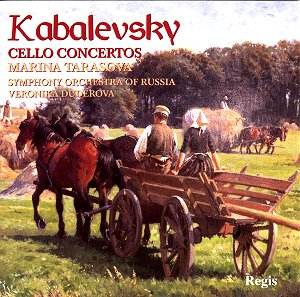Kabalevsky's presence in the West rested on his uproarious
overture to the opera Colas Breugnon. Olympia have done the most
to broaden our knowledge of his music and it is that company who have
licensed this issue to the ever-astute Regis label.
Kabalevsky is not one for challenging music although
by the time of the 1960s his sinews stiffened and an emotional complexity
undreamt of in the 1930s and 1940s began to assert itself. More often
than not though he makes use of his facility for writing flowing and
life-enhancing music. There is little sardonic pepper or macabre salt
in the writing of the First Concerto. Two fluent songful movements
frame a moving threnody for the Soviet millions fallen during the Second
World War. There is a hint of the same nostalgia and of the rhythmic
steel that grips in the music of Kabalevsky's teacher, Miaskovsky who
died the year after this was written.
The Second Concerto was written for and premiered
by Daniel Shafran who had already recorded the First Concerto with the
composer. The three movements played attacca follow the typical
Miaskovsky layout: slow-fast-slow. The middle movement is relentless
and although it provides contrast for the complex and mournful legato
nature of its companions it seems rather like a nod in the ‘right’ direction.
If the facile criticism of ‘Prokofiev and water’ means anything for
the First Concerto you might substitute Shostakovich's name in the case
of the Second Concerto. The work develops an emotional head of steam
in the long final section ending with subtly flavoured understatement.
The two fillers: Improvisato blends Shostakovich
and Fauré while the Rondo motors along with all the torque
and mercury of a Leningrad Khachaturian.
These are successful performances impressive for Tarasova's
sense of flow and colour as well as for the mercurial fantasy and power
of Likhopoi.
Rob Barnett
